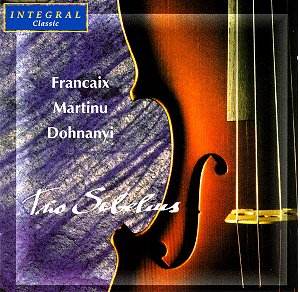Interesting
that this is the second version of Dohnányi’s Serenade,
Op. 10 to come my way recently (see my review of Spectrum
Concerts Berlin on Naxos 8.557153). Interesting, also, that
both this Integral Classic disc and the Naxos disc have
playing times of 47’42 and 50’12 respectively. Perhaps he should
be known as Ernő ‘fifty minutes’ Dohnányi. In all seriousness,
this low playing time seems terribly unfair, particularly as this
new release seems to retail at around full price (at least the
Naxos is only a fiver).
Curiously,
the presentation is the lesser on the more expensive disc. Poorly
proof-read and brief booklet notes hardly help; neither does the
absence of recording information. No catalogue number is given
for the Martinů Trio, nor is the date of composition provided
(actually it is Trio No. 2, but No. 1 is lost). There is no clue
as to date and venue of recording either. All of this is a pity,
as there is much pleasure to be gleaned from this programme.
Whether
the note-writer’s description of Dohnányi’s music as ‘a
sort of mix of Schubert, Brahms and the Gypsies’ fits the aural
evidence is up for discussion. Certainly the Trio Sibelius is
more attuned to the dance elements in this piece than Spectrum
Concerts Berlin. They get closer to the joie de vivre of
the last movement (without quite getting there in the final analysis,
alas) and they are very intimate in the Theme and Variations,
where concentration and intensity are set to maximum. They are
relaxed yet expressive in the Romanza, and project the impassioned
contrasting element better than their Naxos-based rivals. As to
the Marcia first movement, they are almost balletic, less determined
than Spectrum Concerts Berlin. It is only in the Scherzo that
the Naxos account wins out by a clear lead. Trio Sibelius provides
an angular account and is virtuosic (appropriately enough), but
Spectrum Concerts Berlin is distinctly more shadowy and ‘inside’
the music.
Swings
and roundabouts between these two accounts, therefore. If you
want an all-Dohnányi, disc, stick with Naxos for the Sextet,
Op. 37 of 1935. Otherwise the present coupling of Francaix and
Martinů works very well indeed.
The
two-movement Martinů Trio is a wonderful piece. The first
movement is quite acerbic, the Trio Sibelius making the most of
the expressive opportunities. The Poco moderato second movement
contains elements of a Czech homesickness à la Dvořák.
Very much recommended.
Finally,
Jean Françaix’s Trio No. 1 is immediately French in ethos:
sophisticated yet clearly delineated, clear and jovial. The second
movement Scherzo is positively carnivalesque, vividly evoking
the commedia dell’arte. The hushed Andante provides a foil
for the ‘Rondo vivo’, with its party atmosphere. This is joyous,
infectious music whose spiky harmonies can hardly fail to delight.
The
recording is more than acceptable, possessing an affecting warmth.
An enjoyable disc, despite the low playing time.
Colin
Clarke
